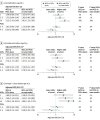Parents' Adverse and Positive Childhood Experiences and Offspring Involvement With the Criminal Legal System
- PMID: 37878312
- PMCID: PMC10600584
- DOI: 10.1001/jamanetworkopen.2023.39648
Parents' Adverse and Positive Childhood Experiences and Offspring Involvement With the Criminal Legal System
Abstract
Importance: Intergenerational cycles of adversity likely increase one's risk of criminal legal system involvement, yet associations with potential contributors, such as parents' adverse childhood experiences (ACEs) and positive childhood experiences (PCEs), have not been explored.
Objective: To investigate the association of parents' ACEs and PCEs with their adult children's involvement in US legal systems, from arrest to conviction.
Design, setting, and participants: The study team analyzed data from the Panel Study of Income Dynamics (PSID), a nationally representative cohort study of families in the US. PSID-2013 survey data were merged with the 2014 PSID Childhood Retrospective Circumstances Study (CRCS), collected May 2014 to January 2015, which asked adults aged 18 to 97 years to retrospectively report on their childhood experiences. Parents and their adult children were linked in the data set. Data were analyzed from October 2022 to September 2023.
Main outcomes and measures: The child arrest outcome was regressed on parents' ACE and PCE scores using logistic regression models. In addition, multinomial logistic regression models were used to assess the associations of parents' ACE and PCE scores with the number of times their child was arrested and convicted.
Results: Of 12 985 eligible individuals, 8072 completed the CRCS. Among CRCS participants, there were 1854 eligible parent-child dyads (ie, parents and their adult children) that formed the analytic sample. The mean (SD) age of offspring at the time of CRCS completion was 38.5 (10.9) years, and 1076 offspring (51.3%) were female. Having 4 or more parental ACEs was associated with 1.91-fold (95% CI, 1.14-3.22) higher adjusted odds of arrest before age 26 and 3.22-fold (95% CI, 1.62-6.40) higher adjusted odds of conviction before age 26 years, compared with children of parents without ACEs. These associations persisted after controlling for parental PCEs.
Conclusions and relevance: In this nationally representative study, children of parents with higher ACEs were at greater risk of arrest during adolescence and young adulthood, even after controlling for parents' PCEs. Addressing and preventing childhood adversity through multigenerational life course approaches may help disrupt intergenerational pathways to the criminal legal system.
Conflict of interest statement
Figures


Similar articles
-
Intergenerational Associations between Parents' and Children's Adverse Childhood Experience Scores.Children (Basel). 2021 Aug 29;8(9):747. doi: 10.3390/children8090747. Children (Basel). 2021. PMID: 34572179 Free PMC article.
-
Parents' Adverse Childhood Experiences and Their Children's Behavioral Health Problems.Pediatrics. 2018 Aug;142(2):e20180023. doi: 10.1542/peds.2018-0023. Epub 2018 Jul 9. Pediatrics. 2018. PMID: 29987168 Free PMC article.
-
Intergenerational transmission of adverse and positive childhood experiences and associations with child well-being.Child Abuse Negl. 2024 Nov;157:107050. doi: 10.1016/j.chiabu.2024.107050. Epub 2024 Sep 19. Child Abuse Negl. 2024. PMID: 39303434
-
Intergenerational transmission and prevention of adverse childhood experiences (ACEs).Clin Psychol Rev. 2021 Apr;85:101997. doi: 10.1016/j.cpr.2021.101997. Epub 2021 Feb 28. Clin Psychol Rev. 2021. PMID: 33689982 Review.
-
Positive Childhood Experiences and Adult Outcomes: A Systematic Review.Trauma Violence Abuse. 2024 Nov 30:15248380241299434. doi: 10.1177/15248380241299434. Online ahead of print. Trauma Violence Abuse. 2024. PMID: 39614772 Review.
Cited by
-
Neuroendocrine mechanisms in the links between early life stress, affect, and youth substance use: A conceptual model for the study of sex and gender differences.Front Neuroendocrinol. 2024 Apr;73:101121. doi: 10.1016/j.yfrne.2024.101121. Epub 2024 Jan 20. Front Neuroendocrinol. 2024. PMID: 38253240 Free PMC article. Review.
References
-
- Centers for Disease Control and Prevention . Adverse childhood experiences (ACEs). Accessed November 8, 2022. https://www.cdc.gov/violenceprevention/aces/index.html
-
- Baglivio MT, Wolff KT, Piquero AR, Epps N. The relationship between adverse childhood experiences (ACE) and juvenile offending trajectories in a juvenile offender sample. J Crim Justice. 2015;43(3):229-241. doi:10.1016/j.jcrimjus.2015.04.012 - DOI
-
- Baglivio MT, Wolff KT. Positive childhood experiences (PCE): cumulative resiliency in the face of adverse childhood experiences. Youth Violence Juv Justice. 2021;19(2):139-162. doi:10.1177/1541204020972487 - DOI
Publication types
MeSH terms
Grants and funding
LinkOut - more resources
Full Text Sources
Miscellaneous

